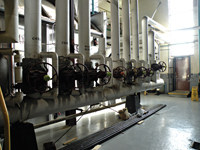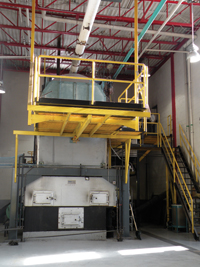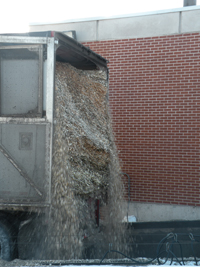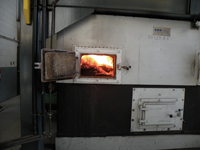
Old-School Heating
December 1, 2010
By
Heather Hager
There’s no smell of smoke, only a light pine scent from the new wood chips being unloaded.
There’s no smell of smoke, only a light pine scent from the new wood chips being unloaded. But on this crisp, –14ºC morning, the boilers are hard at work warming the people and livestock at Nova Scotia Agricultural College (NSAC) in Truro, Nova Scotia.
 |
|
| Both biomass- (right chimney) and oil-fuelled (middle chimney) boilers provide steam to heat Nova Scotia Agricultural College during the winter months.
|
The biomass boiler here has put in 22 years of service and is still going strong. It’s no longer state-of-the-art equipment, but that’s no matter. Over its lifetime thus far, what started as slightly more than a $1-million investment has resulted in estimated fuel savings of over $5 million.
NSAC was heated first with two coal-fired boilers, but they were converted to use no. 2 light fuel oil in 1968, says chief stationary engineer Kevin Craig, who has been with NSAC since 1992. The biomass boiler was installed in response to the late 1970s energy crisis, which kept crude oil prices high into the mid-1980s. “In 1988, the wood chip boiler was commissioned as a showcase for industry, hoping to open the doors for private industry to see it as a working model. And the university wanted the energy savings side of it too,” says Craig.
 |
|
| The boiler house provides steam to heat most of the 34 buildings at NSAC.
|
However, around the time the boiler was installed, oil prices began to drop. Several biomass boilers that were commissioned elsewhere in the region around the same time fell out of favour and ceased operating. NSAC’s biomass boiler was one of the few that kept running. Despite low oil costs, there were substantial fuel savings at NSAC in most years, with the exception of the 1998–1999 heating season, when the savings amounted to about $24.
“I was told that, considering it’s supporting local jobs and local resources, even if we were in the red, it would have to be a fair amount in the red before we’d switch to oil,” says Craig. “Being a government institution, we’re trying to support local jobs and resources to a degree. Also, we’re not going to pack up just because of one year with no savings after many years with savings.”
Oil prices have risen again in recent years, making the investment well worthwhile. It’s resulted in more than $400,000 savings in fuel costs in each of the last five years.
Fibre Supply
Fibre to feed the boiler is obtained through an open bidding process for one-year supply contracts. The main limitation in the process is the dearth of local suppliers in the area, with only one chipping company (North-Lumber-Land Resources) and one grinding company (Verboom Grinders), says Craig. The preferred fuel is chips because of their better flow consistency, but the contract was recently opened to ground biomass to increase competitiveness.
 |
|
| The KMW furnace heats a Matheson boiler, producing up to 15,000 pounds/hour of steam.
|
Contractors dump fibre from walking floor trailers to a belowground storage bin that holds enough biomass to feed the boiler for about 2.5 days. Hydraulic rakes beneath the pile pull fibre towards the first feed-out auger. On really cold days, fibre can freeze in the unheated bin, making the rakes ineffective, says Craig. To reduce freezing and to optimize burning efficiency, a moisture content of 30–50% is specified in the supply contract, with penalties for fibre outside that range. Craig tests fuel moisture manually using a drying oven and balance.
An inclined auger brings the fibre to the KMW furnace, which heats a 272-kW boiler manufactured by I. Matheson & Company of nearby New Glasgow, Nova Scotia. The boiler is rated for 12,000 pounds/hour of steam, but Craig says it’s capable of producing up to 15,000 pounds/hour. The system consumes 6500 to 8800 tonnes of fibre in an average heating season.

|
|
| Wood chips are delivered in walking-floor trailers and unloaded to a small storage bin that holds fuel for about 2.5 days of heating. |
Biomass feeds to the furnace from below, through the centre of a volcano-shaped stationary grate. The fuel dries and then burns as it slides down the grate. “It’s quite different from the newer systems,” explains Craig. “It’s a 1988 model, so there have been changes in technology since then. To me, that’s one of the biggest changes—when that fuel gets in the furnace, our grates are stationary and have to be raked of ash manually.”
Because of that, Craig tries to buy top-quality fuel to minimize issues with ash removal and clinkers. Once a day, the boiler operator on duty rakes ash into chutes to an auger that takes the ash outdoors to an enclosed trailer. Fly ash, which precipitates out of the flue gas in a separator, also goes to the trailer. Ash disposal isn’t too much of a problem; it’s piled outdoors until spring, when it’s mixed with manure and spread on the university’s agricultural fields.
Improving Efficiency
A significant upgrade to the system involved installing variable-speed drives on the stoker auger and the fans that supply air to the furnace, regulating combustion. “Those [fans] were previously just dampers, and we’d be adjusting those dampers based on steam load and fuel, trying to regulate the burn that way. Now, it’s more automated. The variable-speed drives modulate the fans’ speed based on the steam pressure of the boiler,” explains Craig.
 |
|
| Kevin Craig, chief stationary engineer, worked at four other boiler plants before making a home at NSAC.
|
“I was a little skeptical at first, seeing how simple the system was going to be,” he says. “But for the most part, once you get it set up, the burn seems to be pretty consistent.”
Craig has a few items on his wish list for future improvements. He thinks that a bigger storage space for stockpiling the biomass would allow the supplier to skip processing and delivery on wet and stormy days, resulting in drier fuel. Taking the pressure off the supplier for almost daily delivery could also help to moderate the price of fuel. Craig also thinks that an economizer would capture some of the excess heat from the flue gas, making the system even more efficient. Most of all, he’d like to add another biomass boiler to the fleet.
“It seems every other year they’re building another building or expanding the size of buildings. But even when it [the biomass boiler] was installed in 1988, it wasn’t large enough to heat the university entirely.” That means the university is burning more oil each year as it grows in size.
These days, the biomass boiler is supplemented by a 260-kW Cleaver Brooks boiler running on no. 2 oil and producing up to 12,000 pounds/hour of steam. On a cold winter day, the boiler house output can be 24,000 pounds/hour of steam, meaning that both boilers are running at maximum capacity. In summer,
however, only the oil boiler runs.
 |
|
| The old-style KMW furnace must be raked of ash manually at least once per day. Newer models feature moving grates and automatic ash removal.
|
“All boilers have a turndown ratio, a minimum fire and a maximum fire,” explains Craig. NSAC’s summer steam demand is too low for the biomass boiler’s minimum fire. “If you get a larger boiler, now your minimum fire is higher, and that means on warmer days, you can’t run that. I think the direction I’d be looking at is another biomass boiler to supplement this one and allow more versatility in the range of operation.”
From all appearances, the savings from burning biomass instead of oil would be well invested in making Craig’s wish for a second biomass boiler come true.
Print this page